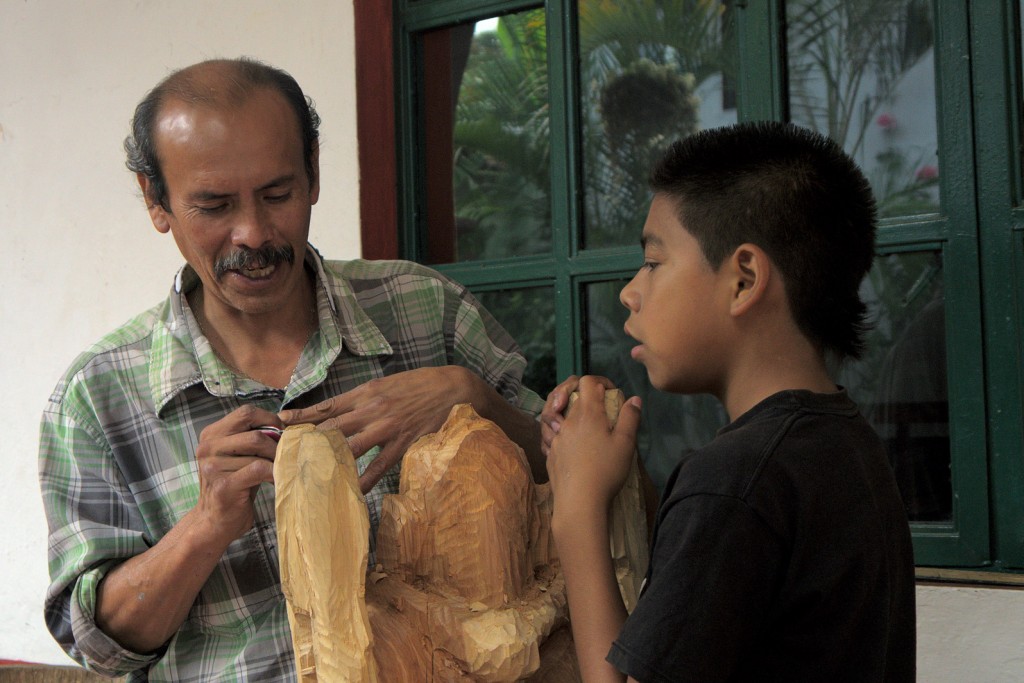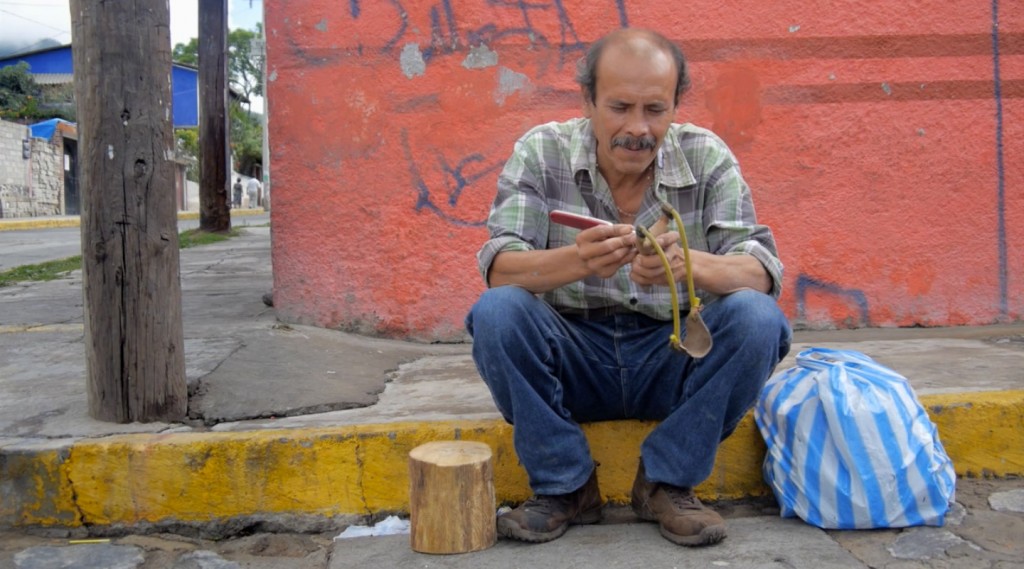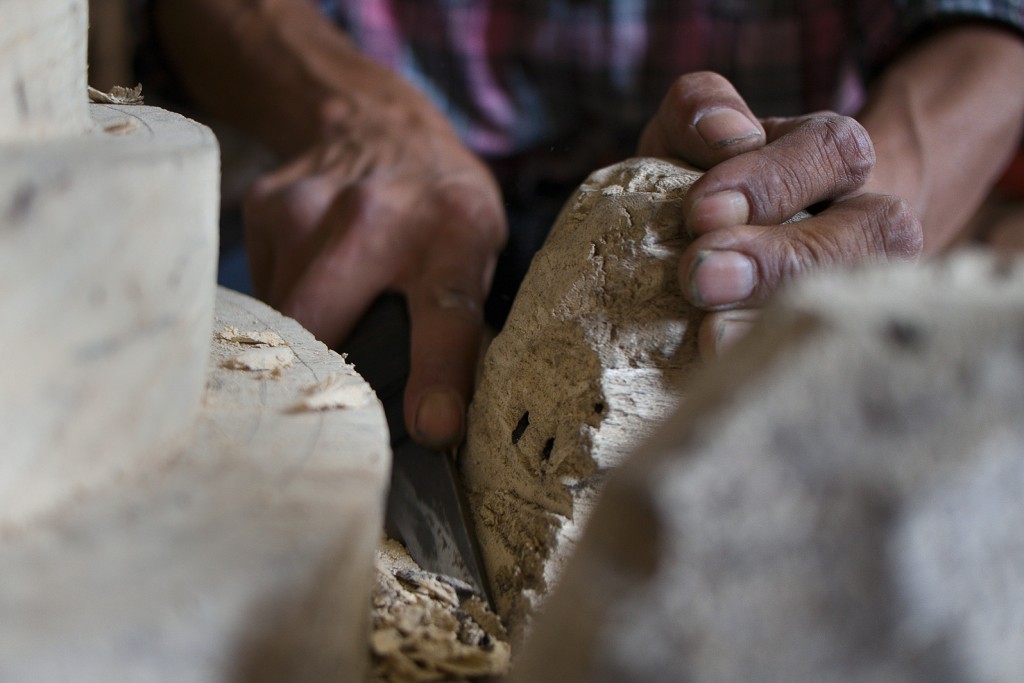Gary’s Art
Narrative by Jason Yang
Translation by Aidé Aranda
Photograph by Cristobal Ortega

Gary helps a student at the Malinalco Cultural Center.
One afternoon in the corridor of Malinalco’s cultural center, a young boy with a wooden board tucked under his arm approaches a thin man with gray hair. “Can you help me with this?” the boy asks.
Gary places the board on his lap. His right hand grips the pocket knife, forming a horizontal thumbs-up sign. He holds his left thumb against his right thumb, moving the knife away from his body. The wood shreds off like ribbons.
“You can’t use brute strength, or you’ll hurt your shoulder,” says Gary. “Push your weight away from your body.”
The boy watches Gary’s motion as he cleaves out a piece of the wood. “Now you try.” Gary flips the board around and hands it to the boy.
Edgar “Gary” Monroy, 48, teaches his woodcraft workshop at the town’s cultural center every Wednesday and Friday afternoon. The workshops, funded by the local government since early 2000, attract students ranging in age from 13 to 30. They chip tree trunks into artwork such as Hermes’ head or Aztec figures.
Gary won Mexico’s national woodcraft competition in 1994. His love for woodcraft helped him overcome his financial and personal struggles. Now he passes his wisdom to the future generations.
He and his peers have also been teaching woodcraft to battle the town’s high unemployment rate. The town suffered an increase of 4.2 percent in the unemployment rate from 1980 (.2 percent) to 2010 (4.4 percent), according to municipal court records. The town registered 107 carvers as of April 2013.
Talladores, or carvers, have existed in Malinalco since the pre-Hispanic era. Aztecs would carve stones like the ones near the Cuauhtinchan Pyramid. The tradition continues today in Gary and his peers.
“Woodcraft is the image of Malinalco,” says Jesus Silva, manager of Malinalco’s tourism office. He was the second place winner in the 1994 national competition. Besides giving residents a skill, the art has attracted tourists since the early 1990s, and their spending has helped the town’s economy, Silva said.
“Gary has done so much free community work, he has become one of the most prestigious artists in the community,” says Ellen Calmus, project coordinator for The Corner Project — whose mission is to promote Malinalco’s educational and economic development.
“He’s the teacher of teachers of teachers,” Calmus said. “He supports the community.”

Gary sits by the corner of the sidewalk near San Juan Calley Centro church. His left hand holds a wooden slingshot while the lima knife in his right hand carves out the details of an ox head.
Each swipe of his knife creates a feature in the head. Horses and taxis pass by him, but his eyes remain on his work.
The kids in Malinalco love slingshots, which they can use to knock fruit off trees.
When he was 14, Gary lost his cousin’s slingshot, so he made another by hand with wood. His cousin couldn’t believe he made it because of the detail on the handle. One day, Gary took it to the Archaeological Zone and a tourist offered to buy it. He knew he had the talent then.
But Gary’s parents worried about his passion. Gary grew up as a shepherd, the inheritor of the family’s barbocoa business. Gary says they didn’t want their son doing something that would “leave him in poverty.”
In the morning, he would sell barbocoa with his parents. In the evening, he would make wooden toys by hand and hide them under his bed. “I like [making barbocoa], but I love art,” Gary says.
He met his woodcarving master, Manuel Espinoza, during an art workshop at the cultural center. His teacher showed him that detail is not just an essential element to art, but also a window to more opportunities.
Inspired, Gary attended at a fine arts school in Toluca. There he learned details of the human anatomy, measurements for precision and accuracy, and art skills to vivify his work.
But during his junior year, his girlfriend, Elizabeth, became pregnant with their son, Jose. “It was a hard time because I had to take care of my wife and son, while focusing on my education in Toluca.”
Gary sits outside his house, a 700-square-foot concrete building. Surrounded by mountains and trees, he hacks away at a piece of wood, forming the base of the Cuauhtinchan pyramid. An earthy smell pervades his workshop.
He sees his grandson walking with Elizabeth, picks him up and carries him to his workspace.
“Do you want to play with the hammer?” says Gary, who clutches the mazo hammer around his grandson’s right hand, while the left clenches to the formol chisel.
Koh Koh Koh. Gary guides the grandson’s hand and pounds mazo against the formol, shaping and smoothing the wood into a flat surface. The grandson’s eyes wander around Gary’s old crafts.
Today, Gary is a father of two children and one grandson.
At 22, he returned to Toluca after completing his degree. Without a secure job and financial stability, his family rented a
small room with a stove, bed, and bathroom. They struggled with rent and food.
On weekends, Elizabeth worked a taco cart and sold hand-knit clothes. Gary sold paintings and ran the family’s barbocoa stand once a month. “I would panic about money at times,” Elizabeth says. “But he would always say it’s not the money but the experience.”
Yet there were good times during the struggles. The family took walks during their free time or dined in a restaurant after Gary sold a piece. This lifestyle lasted for 10 years.
“I stayed with him because I lost my father when I was 10,” Elizabeth says. “So I believe a child should grow under a father’s guidance.”
At 29, Gary saw an ad promoting a national woodcraft tournament a month before the competition. He entered the competition with an image of Aztec God Quetzalcoatl and white butterflies, made of bones, engraved on a wooden rain stick.
Gary was surprised when he heard his name as the first place winner. The reporters asked him for a comment after his win. His response? “It’s nice because I can pay off my debt.”
With his cash prize, Gary bought the land he currently lives on from his mother-in-law. He had to borrow 70,000 pesos from the bank to decorate the home. Winning the tournament legitimized his status as a great woodcrafter. But he continued to work as a janitor and painter at the cultural center, giving art lessons to pay the bills.
Today, he has sold more than 200 pieces to clients in Europe, Russia, Bolivia and other places. He has taught hundreds of local woodcrafters. A Japanese client recently requested an order of Quetzalcoatl because of Gary’s traditional handcraft skill.
Gary paid 1,000 pesos each month to clear his debt. He evened the debt last month. However, the family is barely making ends meet. A foot-and-a-half sculpture would sell for 5,000 pesos, but he would rarely make any profit after all the expenses.
Elizabeth still has to work a taco cart on the weekends. Jose sells his own crafts, such as key chains, to help with the bills.
But the family is happy with this lifestyle. “I want more space and a room for each person,” Elizabeth says. “I know little by little, we will obtain everything.”

Gary begins to carve a pyramid for a commissioned sculpture.
The clock in the culture center’s corridor strikes 4:30 p.m. Clouds loom above the town. The workshop doesn’t start until 5, but 14 students have already congregated in the center, working on their pieces. Gary walks around the corridor and notices a high school student using the wrong knife technique.
“You have to use the top of the knife to carve,” Gary says. He sharpens the knife and begins to slice the wood outward. “The knife will cut you if you use too much feeling.”
“So it’s just like using the tip of formol?” responds Ulises Aquacate Gonzalez, holding the chisel in front of him.
Ulises looks up to Gary. “[Woodcraft] makes me proud to be a Mexican,” Ulises says.
Gary commits to the workshops and the community because he never had these opportunities when he was younger. But because he spends the majority of his time contributing to the community, he doesn’t have time for his career. He plans to quit the job to focus on his career when his contract expires. But he hopes to teach his students as much as possible before then.
He always reminds them about the importance of community. “Time doesn’t exist, we exist in it. Conflict, war, they don’t move. We do. But your roots will always be there. Never give up your roots,” Gary says.
“[The students] are the most important because I love them,” Gary says. “I want to teach them to be humble and to respect their work. Art is more than philosophy and life.
“Art teaches you to care about the people and things around you.”
Artists of Life
Producido por Cristobal Ortega
Translation by Aidé ArandaCristobal follows Ulises, a young artist in wood and in life.
See more…
